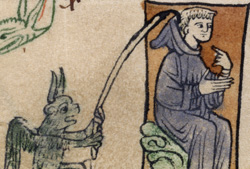 |
 |
 |
 |
 |
 |
 |
|
Fountains Abbey: History
Fountains Abbey: Buildings
|
Tumult at St Mary's (2/5) A report spread abroad that there had come from
a far country The group of Clairvaux monks sent to establish the first Cistercian community in the North of England, made a phenomenal and lasting impact on the Benedictine abbey of St Mary’s, York. News of these holy and religious men, and of their simple way of life at Rievaulx, near Helmsley, fanned discontent amongst a band of high-minded monks of St Mary’s, who were incited to seek the reform of their own abbey. The group included a number of the abbey’s leading monks, amongst them, Prior Richard. They objected to the community's preoccupation with worldly concerns, in particular the rich and abundant diet, ornate clothing and tendency to gossip, quarrel and even engage in dirty talk.(20)
The group’s desire for reform was neither shared nor appreciated by Abbot Geoffrey of St Mary’s, ‘a man undoubtedly honest and good, as far as his sense and intelligence went, but somewhat simple and uneducated.’(21) He dismissed this as 'novelty', threatened the monks with disobedience and took decisive action to curb any prospect of change. Geoffrey’s efforts were however, in vain, for the more he tried to dissuade them, ‘the more did the fire burn, fed with the fuel of fervour and faith.’(22) Deeply committed to a more rigorous way of life, Prior Richard sought the help of Thurstan, archbishop of York, who subsequently planned to visit St Mary’s, to negotiate peace. His visit had unimaginable consequences and resulted in the reforming party fleeing for their lives, clinging to the archbishop for safety. The monks’ departure set the wheels in motion for the foundation of Fountains: All desired
the holy simplicity of the Cistercian Order, to be grafted |
